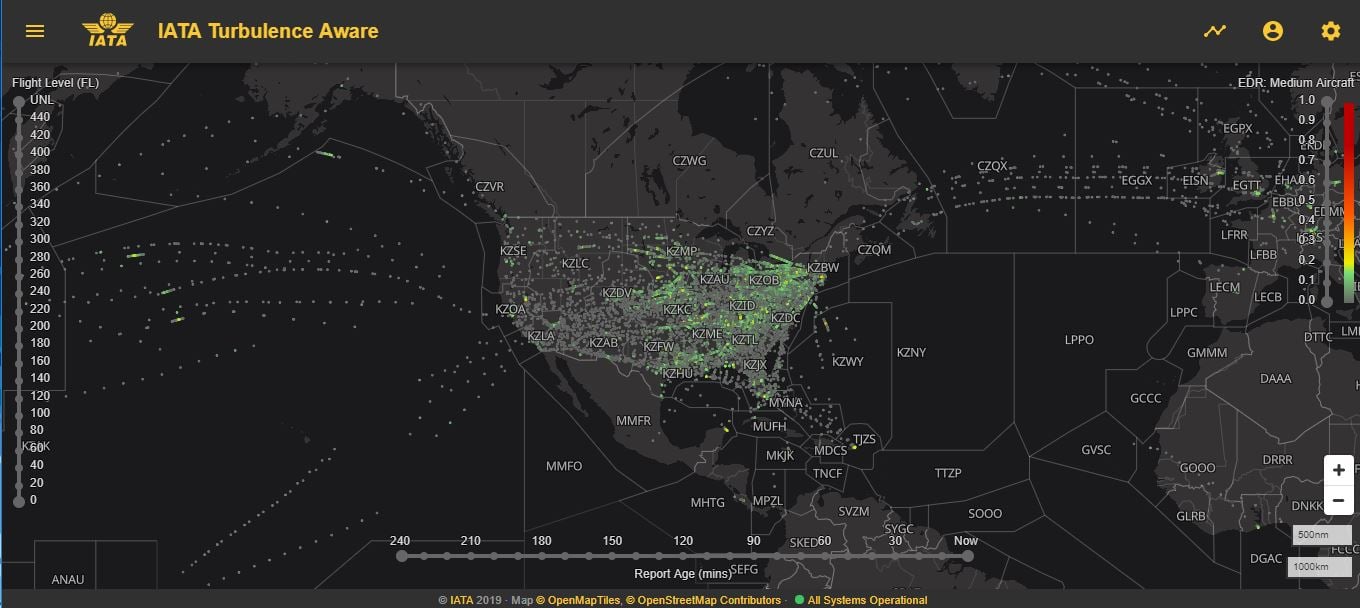
Turbulence costs airlines millions of dollars every year. As the leading cause of non-fatal injury and damage, airlines need better tools to help mitigate the effects of turbulence on a flight.
IATA Turbulence Aware is an innovative, user-friendly software that provides pilots and flight dispatchers with accurate, quantitative data on turbulence in real-time, so they can plan and navigate safer, faster, and more efficient flight paths at any stage of a journey.
Do you want a better way to deal with turbulence?
Here are some important things to consider:
Turbulence is the leading cause of injuries to cabin crew and passengers in non-fatal accidents. In addition to creating fear and uncertainty for many air travelers, turbulence costs the airlines of millions of dollars annually and negatively impacts their brand reputation.
Academic research shows that the rate of turbulence will increase by 149% in the upcoming years. In addition to its increased frequency, turbulence will become more severe and more damaging in its scale. As a result, it’s vital that the aviation industry adopt more sophisticated tools to measure, report, and navigate these new environments to ensure safe and effective air travel for all stakeholders.
As the global trade association for airlines, IATA is dedicated to improving air travel for all key stakeholders while also providing clear, accurate, and thorough data that can help industry leaders maximize efficiency and safety within their operations.
IATA developed Turbulence Aware to give airlines more accurate and useable information to mitigate issues caused by turbulence on every flight.
If a trailing aircraft observes turbulence on an aircraft ahead then the pilot can secure the cabin more effectively, helping to mitigate the chance of injury for their passengers. Furthermore, if there is sufficient time, the pilot can also request a different altitude or heading to avoid turbulence.
Either way, having an accurate reading of turbulence during a flight gives pilots and dispatchers a clearer lens to make better decisions regarding flight paths and safety measures.
The information collected and reported by Turbulence Aware is very valuable for those who want to enhance Standard Operating Procedures (SOPs) for fuel-efficiency. In addition to turbulence readings, Turbulence Aware collects and reports various parameters so pilots can make more informed decisions regarding adjusting flight levels on their route to increase fuel efficiency.
Subjective turbulence reports lead to ambiguity and misinformation. A pilot’s assessment of turbulence may be based on their flight experience, personality, and, more significantly, the type of plane they’re flying.
For example — a pilot flying a King Air may not detect any turbulence whereas an A320 will experience light turbulence when on the same flight path.
As such, the best method to measure turbulence is the Eddy Dissipation Rate (EDR).
The EDR measures the state of the atmosphere around an aircraft in flight. This reading can be ascertained by installing a simple software that will collect real-time data and report that information almost instantaneously.
Parameters below:
| Parameter | Explanation | Example |
|
Observation Time |
Time of report in UTC | 2020-05-13T00:00:00Z |
| Altitude | Altitude Above Sea Level in feet | 35,000 ft |
| Latitude | Geographical coordinate of the report for latitude | 22 |
| Longitude | Geographical coordinate of the report for longitude | 120 |
| Peak EDR | Maximum EDR value in the calculation | 0.37 |
| Mean EDR | Average EDR value of the calculation | 0.12 |
| Wind Speed | Wind speed in knots | 40kt |
| Wind Direction | Wind direction in radial | 270º |
| Static Air Temperature | Temperature in degrees celsius | -55.0ºC |
How is turbulence calculated using EDR?
The EDR algorithm uses atmospheric and aircraft data to calculate turbulence values. Several planes are already equipped with EDR capabilities. For planes that don’t already have EDR capabilities, a simple software installation is all you need to ascertain these measurements — no hardware is required.
IATA endorses a free open-source EDR algorithm developed by the National Center of Atmospheric Research (NCAR). Airlines can either do an in-house EDR implementation with the help of free IATA support or they can pay an implementation fee to a third party.
Turbulence Aware is a global platform for sharing automated EDR turbulence reports in a matter of seconds. Here are the steps:
Pilots and dispatchers can see the data using the MET Viewer which uses either an internet connection or another in-house method. Airlines also have the option to get a third party to act as an authorized agent and integrate the data back to an in-house platform for pilot and/or dispatcher access.
The MET Viewer is IATA’s Platform to display turbulence reports from Turbulence Aware.
The viewer gives you detailed turbulence reports and location, integration flight plans and observing trajectory of turbulence reports.

Turbulence Aware offers you the most accurate real-time data on turbulence. A user-friendly tool, Turbulence Aware can be overlaid onto your existing suite of tools. Or, it can be fully integrated into your system. You have the flexibility to operationalize the data however you see fit. But in the end, Turbulence Aware will give you valuable insight to make better decisions about flight paths before and during a flight — optimizing both safety and enjoyment for your passengers and staff.
Market research shows us that turbulence can cost airlines anywhere from $250K to $2 Million dollars per year. Turbulence Aware allows airlines to be more strategic and adaptive to turbulence issues so they can avoid unnecessary and costly damages to planes, crew, and passengers, alike.
Currently, 21 airlines are involved with Turbulence Aware and contributing data to this open-source platform. Leading airlines like Qatar Airways, Delta Air Lines, and Southwest Airlines, rely on Turbulence Aware to ensure smoother and safer flights for their customers and crew. Turbulence Aware is also suitable for ANSPs, OEMs, Meteorological Organizations, Business Aviation, and data integrators.
Users tell us that they like Turbulence Aware because it’s easy to use and provides very detailed data to help them fly better and safer.
You don’t need to rely on subjective information anymore. Turbulence Aware gives you extraordinarily accurate real-time data to make better decisions for smoother, safer flights.
Avoid the costly repercussions of turbulence. And make flights more enjoyable for passengers and crews, alike.
Please complete the form below to access frequently asked questions, overview of the EDR guidelines and sample viewer cases.